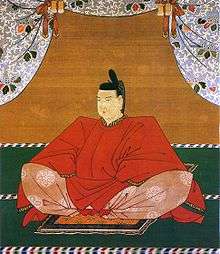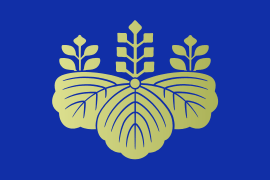Emperor Ichijō
| Ichijō | |
|---|---|
| Emperor of Japan | |
 Ichijō | |
| Reign | 986–1011 |
| Coronation | 986 |
| Predecessor | Kazan |
| Successor | Sanjō |
| Born |
July 15, 980 Heian Kyō (Kyōto) |
| Died |
July 25, 1011 (aged 31) Heian Kyō (Kyōto) |
| Burial | En'yū-ji no kita no misasagi (Kyoto) |
| Spouse |
Fujiwara no Teishi Fujiwara no Shōshi |
| Father | En'yū |
| Mother | Fujiwara no Senshi |
Emperor Ichijō (一条天皇 Ichijō-tennō, July 15, 980 – July 25, 1011) was the 66th emperor of Japan,[1] according to the traditional order of succession.[2]
Ichijō's reign spanned the years from 986 to 1011.[3]
Traditional narrative
Before he ascended to the Chrysanthemum Throne, his personal name (imina) was Kanehito -shinnō.[4] Kanehito-shinnō was the first son of Emperor En'yū and Fujiwara no Senshi, a daughter of Fujiwara no Kaneie. Since there are no documented siblings, it is supposed that he was an only child.
Ichijō had five Empresses or Imperial consorts and five Imperial sons and daughters.[5]
Events of Ichijō's life
His reign coincided with the culmination of Heian period culture and the apex of the power of the Fujiwara clan.
In 984, he was appointed as crown prince under Emperor Kazan. It was rumored contemporarily that his maternal grandfather Kaneie plotted to have Kazan retire from the throne.
Ichijō ascended the throne at the age of six.
- July 31, 986 (Kanna 2, 22nd day of the 6th month): In the 2nd year of Emperor Kazan's reign (花山天皇二年), he abdicated; and the succession (senso) was received by a cousin, the son of his father's younger brother.[6]
- August 1, 986 (Kanna 2, 23rd day of the 6th month): Emperor Ichijō is said to have acceded to the throne (sokui).[7]
A son of Emperor Reizei, who was older than Ichijō, was appointed crown prince. Kaneie became the regent (Sesshō) and effectively ruled the state. After Kaneie died in 990, his first son and Ichijō's uncle Fujiwara no Michitaka was appointed regent.
- March 1, 991 (Shōryaku 2, 12th day of the 2nd month): The former-Emperor En'yū died at the age of 33.[8]
- 1008 (Kankō 5, 8th day of the 2nd month): Kazan died at the age of 41.[9]
- July 16, 1011 (Kankō 8, 13th day of the 6th month): In the 25th year of Emperor Ichijō's reign (一条天皇二十五年), the emperor abdicated; and the succession (senso) was received by his cousin. Shortly thereafter, Emperor Sanjō is said to have acceded to the throne (sokui).[10]
- July 25, 1011 (Kankō 8, 22nd day of the 6th month): Emperor Ichijō died.[9]
Ichijō had two empress consorts. First was Teishi (or Fujiwara no Sadako), a daughter of Fujiwara no Michitaka, second was Shōshi (or Akiko), a daughter of Fujiwara no Michinaga, a younger brother of Michitaka. Most people thought it impossible to have two empress consorts, but Michinaga claimed that the empress held two separate titles, Chūgū and Kōgō, which were different in principle and could therefore given to two different women.
The courts of both empresses were known as centers of culture. Sei Shōnagon, author of The Pillow Book, was a lady in waiting to Teishi. Murasaki Shikibu was a lady in waiting to Shoshi. There were other famous poets in the courts of the empresses.
Ichijō loved literature and music. For this reason, high ranked courtiers felt the necessity for their daughter to hold cultural salons with many skillful lady poets. Particularly he was fond of the flute. Ichijō was known for his temperate character and was beloved by his subjects.
During Ichijō's reign, Imperial visits were first made to the following four shrines: Kasuga, Ōharano, Matsunoo, and Kitano; and in the years which followed, Emperors traditionally made yearly Imperial visits to these shrines and to three others: Kamo, Iwashimizu and Hirano.[11]

The actual site of Ichijō's grave is known.[1] This emperor is traditionally venerated at a memorial Shinto shrine (misasagi) at Kyoto.
The Imperial Household Agency designates this location as Ichijō's mausoleum. It is formally named En'yū-ji no kita no misasagi.[12]
Ichijō is buried amongst the "Seven Imperial Tombs" at Ryoan-ji Temple in Kyoto.[13] The mound which commemorates the Emperor Ichijō is today named Kinugasa-yama. The emperor's burial place would have been quite humble in the period after Ichijo died.
These tombs reached their present state as a result of the 19th century restoration of imperial sepulchers (misasagi) which were ordered by Emperor Meiji.[14]
Kugyō
Kugyō (公卿) is a collective term for the very few most powerful men attached to the court of the Emperor of Japan in pre-Meiji eras.
In general, this elite group included only three to four men at a time. These were hereditary courtiers whose experience and background have brought them to the pinnacle of a life's career.
During Kazan's reign, this apex of the Daijō-kan included:
- Sesshō, Fujiwara no Kaneie (藤原兼家), 929–990.[15]
- Sesshō, Fujiwara no Michitaka (藤原道隆), 953–995.[16]
- Kampaku, Fujiwara no Kaneie.[15]
- Kampaku, Fujiwara no Michikane, 961–995.[15]
- Daijō-daijin, Fujiwara no Kaneie.[15]
- Daijō-daijin, Fujiwara no Yoritada (藤原頼忠), 924–989.[17]
- Daijō-daijin, Fujiwara no Tametisu (藤原為光), 942–992.[17]
- Sadaijin, Fujiwara no Michinaga (藤原道長), 966–1027.[17]
- Udaijin, Fujiwara no Michikane (藤原道兼).[16]
- Naidaijin, Fujiwara no Michitaka.[16]
- Naidaijin, Fujiwara no Korechika (藤原伊周), 973–1010.[17]
- Naidaijin, Kan'in Kinsue (藤原公季), 956–1029.[8]
- Dainagon
Eras of Ichijō's reign
The years of Ichijō's reign are more specifically identified by more than one era name or nengō.[18]
- Eien (987–988)
- Eiso (988–990)
- Shōryaku (990–995)
- Chōtoku (995–999)
- Chōhō (999–1004)
- Kankō (1004–1012)
Consorts and children
Empress (Kōgō): Fujiwara no Teishi/Sadako (藤原定子) (977–1001), 1st daughter of Fujiwara no Michitaka (藤原道隆)
- Imperial Princess Shushi (脩子内親王) (997–1049)
- Imperial Prince Atsuyasu (敦康親王) (999–1019)
- Imperial Princess Bishi (1001–1008)
Empress (Chūgū): Fujiwara no Shōshi/Akiko (藤原彰子) (988–1074), daughter of Fujiwara no Michinaga (藤原道長); later Nyoin (女院) 'Jōtō-mon In' (上東門院)
- Imperial Prince Atsuhira (敦成親王) (1008–1036) (Emperor Go-Ichijō)
- Imperial Prince Atsunaga (敦良親王) (1009–1045) (Emperor Go-Suzaku)
Nyōgo: Fujiwara no Gishi (藤原義子) (974–1053), daughter of Fujiwara no Kinsue (藤原公季)
Nyōgo: Fujiwara no Genshi (藤原元子) (?–?), daughter of Fujiwara no Akimitsu (藤原顕光); later, married to Minamoto no Yorisada (源頼定)
Nyōgo: Fujiwara no Sonshi (藤原尊子) (984–1022), daughter of Fujiwara no Michikane (藤原道兼); later, married to Fujiwara no Michitō (藤原通任) in 1015
Court lady (Mikushige-dono-no-Bettō): 4th daughter of Fujiwara no Michitaka (藤原道隆の娘) (?–1002)
Notes

- 1 2 Imperial Household Agency (Kunaichō): 一条天皇 (66)
- ↑ Ponsonby-Fane, Richard. (1959). The Imperial House of Japan, pp. 66–67.
- ↑ Brown, Delmer et al. (1979). Gukanshō, pp. 302–307; Varley, Jinnō Shōtōki, p. 73; Titsingh, Isaac. (1834). Annales des empereurs du japon, pp. 150–154., p. 150, at Google Books
- ↑ Varley, p. 192; Brown, p. 264; prior to Emperor Jomei, to the personal names of the emperors were very long and people did not generally use them. The number of characters in each name diminished after Jomei's reign.
- ↑ Brown, p. 307.
- ↑ Titsingh, p. 149; Varley, p. 44; a distinct act of senso is unrecognized prior to Emperor Tenji; and all sovereigns except Jitō, Yōzei, Go-Toba, and Fushimi have senso and sokui in the same year until the reign of Emperor Go-Murakami.
- ↑ Brown, p. 302; Varley, p. 44.
- 1 2 Brown, p. 305.
- 1 2 Brown, p. 306.
- ↑ Titsingh, p. 154; Brown, p. 307; Varley, p. 44.
- ↑ Brown, p. 307 n22.
- ↑ Ponsonby-Fane, p. 421.
- ↑ The "Seven Imperial Tombs" at Ryoan-ji are the burial places of Uda, Kazan, Ichijō, Go-Suzaku, Go-Reizei, Go-Sanjō, and Horikawa.
- ↑ Moscher, Gouverneur. (1978). Kyoto: A Contemplative Guide, pp. 277–278.
- 1 2 3 4 Brown, p. 302-303.
- 1 2 3 Brown, p. 303.
- 1 2 3 4 Brown, p. 304.
- ↑ Titsingh, p. 150.
References
- Brown, Delmer M. and Ichirō Ishida, eds. (1979). Gukanshō: The Future and the Past. Berkeley: University of California Press. ISBN 978-0-520-03460-0; OCLC 251325323
- Moscher, Gouverneur. (1978). Kyoto: A Contemplative Guide. ISBN 9780804812948; OCLC 4589403
- Ponsonby-Fane, Richard Arthur Brabazon. (1959). The Imperial House of Japan. Kyoto: Ponsonby Memorial Society. OCLC 194887
- Titsingh, Isaac. (1834). Nihon Odai Ichiran; ou, Annales des empereurs du Japon. Paris: Royal Asiatic Society, Oriental Translation Fund of Great Britain and Ireland. OCLC 5850691
- Varley, H. Paul. (1980). Jinnō Shōtōki: A Chronicle of Gods and Sovereigns. New York: Columbia University Press. ISBN 978-0-231-04940-5; OCLC 59145842
See also
| Regnal titles | ||
|---|---|---|
| Preceded by Emperor Kazan |
Emperor of Japan: Ichijō 986–1011 |
Succeeded by Emperor Sanjō |
| ||||||||||||||||||||||||||||||||||||||||||||||||||||||||||||||||||||||||||||||||||||||||
|
